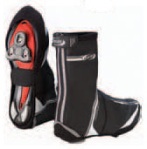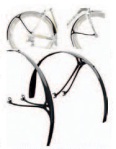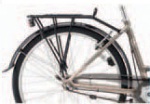Don’t let the cold and rain stop you having fun on your bike; Margot McGovern has plenty of tips to keep you riding throughout the winter.
 Bike riders in the northern hemisphere keep pedalling through snow, ice and sub-zero temperatures. With our comparatively mild winters, Australians have no excuse for giving up their wheels in cooler months. However, winter does bring new challenges, and riders need to adjust their style and equip themselves and their bikes to accommodate the cold weather, wet conditions and low visibility.
Bike riders in the northern hemisphere keep pedalling through snow, ice and sub-zero temperatures. With our comparatively mild winters, Australians have no excuse for giving up their wheels in cooler months. However, winter does bring new challenges, and riders need to adjust their style and equip themselves and their bikes to accommodate the cold weather, wet conditions and low visibility.
Beating the cold
When the temperature drops instinct tells us to rug up, but ironically, overheating is a common problem for winter riders.
If you feel cosy when you set out, you’re likely to be uncomfortably roasting ten minutes into the ride. It’s tempting to opt for a thick, waterproof jacket, but even breathable fabrics often won’t let enough heat escape.
The trick to keeping warm without overheating is layers. Start with a snug-fitting Merino base layer that wicks moisture away from your skin. Opt for light, wind-resistant outer layers, preferably with zippered vents that can be opened if you start to toast; good underarm venting is particularly important.
Some riders are happy to wear shorts all winter, relying on fast pedal cadence generating enough heat in the leg muscles to keep them warm. But for most people, some sort of leg covering is necessary, with knee protection a priority. Knicks that are at least three-quarter length, or compression leggings worn under shorts, work well against the cold air.
On dry days a vest or gilet keeps your core warm while allowing your arms to breathe. Lycra sleeves and leg warmers are also a good idea and can be removed once you’ve warmed up.
Your hands and feet are most exposed to the elements, and susceptible to the cold; given these are primary contact points with the bike, they need to be protected from going numb.
Purchase good quality gloves that are windproof, waterproof and grippy, but not so thick that you can’t comfortably feel and operate your gear and brake levers. Avoid woollen gloves; although warm, wool is too slippery to give a firm hold on the handlebars.
Wear two pairs of thin wool socks to keep your feet warm, along with overshoes (‘booties’) to keep out the wind, and, depending on the design, rain and road grit.
Ski-type headbands are great for protecting exposed ears, while skull caps, woollen beanies, riding caps and helmet covers can help prevent heat from escaping through the top of your head. Neck gaiters can also be very useful, and unlike scarves, they don’t have a flapping tail and can be pulled up to make a balaclava for cold noses when it’s really chilly.
Riding in the cold is deceptive. We appear to sweat less and don’t feel thirsty as often. However, our bodies are working extra hard to radiate more heat, which expends a lot more energy than normal. Make sure you take enough energy-rich food and water to last the distance of your ride.
Keeping dry

You can turn riding in the rain from a soggy experience into an invigorating and exhilarating one, but you must be well prepared.
Waterproof outer layers – overpants, jackets, capes, ponchos, gloves and neoprene booties – will keep you dry from most rain, but avoid bulky gear that will trap heat and sweat or you’ll end up uncomfortably hot, and wetter from sweat than you would from the rain.
Bike-specific clothing, such as Ground Effect, is usually the best option; rain jackets, for instance, will usually come with long tails to protect your rear, longer arms for when you’re stretching out on the handlebars, and have appropriately placed vents.
For commuting, pack spare clothes in a waterproof bag, backpack or pannier. If you use a pack, buy a rain cover for it. Wrapping your clothes in plastic (a shopping bag will do) offers double protection against spending a day in damp gear. It’s also good practice to pack your wallet, phone and other valuables in a waterproof bag – sealable sandwich bags are perfect.
Mudguards are an absolute necessity in the rain, and modern materials and design mean they are no longer the rattling, heavy

and ugly eyesores of the past. They give vital protection to you, your gear and your bike’s components from the rain and muck thrown up by your wheels and they’ll also save you from the uncomfortable and unsightly embarrassment of a ‘rooster tail’ splattered up your back.
Full front and rear mudguards are best as they deflect most of the road’s upchuck, but not all bikes can accommodate them. Many road bikes lack the mounts to attach traditional mudguards and only have a tiny clearance between the top of their wheels and the bottom of their brake calipers. They need special, ultra-thin mudguards, or cut-down guards that clip on to a bracket that runs under the brake calipers. Manufacturers of these guards include Topeak, BBB, Crud and SKS.
Another alternative is to fit guards made for mountain bikes that clip on to the seat post for rear-wheel protection, and a paddle-like guard secured to the downtube to protect from front-wheel splash. They are moderately successful and will help keep you dry, but following riders will still be sprayed.
Bikes require extra maintenance in wet weather. Water can get trapped inside the frame, so after a ride in the rain tilt your bike

vertically to release water through its drain holes, usually located in the rear stays and/or fork.
The chain collects more dirt and needs more attention in the wet. Consider switching to a wet lube, and if you can, after every wet ride rinse your chain with clean water then run it backwards between the folds of a clean cloth until it is mostly dry.
Water, grime and grit trapped between brake pads and wheel rims can mean brakes take much longer to grip in the rain. Make sure your brakes are well adjusted before you set out, and ride at slower speeds if necessary while allowing more time to stop. Before the need for hard braking arises, lightly apply the brakes to squeegee excess water off your rim.
The grimy road paste will also wear down your brake pads and rim; if you can, rinse both clean after your ride.
Tyres have less traction on wet surfaces, particularly around corners. Start braking early to prevent

skidding, and avoid leaning deeply into corners and approaching them at speed.
Metallic surfaces, such as manhole covers, and painted surfaces, including lane markings, are especially slippery when wet. Avoid them if possible; brake or turn sharply on these surfaces and you’re likely to be off your bike examining them at painfully close range.
Tram lines are a particular problem. If they can’t be avoided, they should be crossed at a minimum of 45º, and try and keep in a very upright position. If turning right means you must pass over tram tracks, consider doing a hook turn so you cross them at close to 90º.
Tread that you see in car tyres disperses water, but is unnecessary on the slower-rotating bike tyres. But consider running wider tyres in the winter, as they do give more grip on wet roads, and you can add some grip on your existing tyres by lowering their pressure a few pounds below the recommended psi.
Expect more punctures in the rain, typically in your back wheel, where most of your weight is. Rain washes glass shards and

other debris lying dormant in the road surface out and towards the road edges, right into a bike rider’s path.
Take precautions by fitting tyres with added built-in puncture protection, such as a Kevlar strip or similar; they cost a bit more, but are well worth it. A tube of Slime pumped into your tube is also a good investment; it self-repairs most small punctures by quickly filling the hole and hardening upon contact with the air before much tube pressure is lost.
Low visibility
With the daylight hours short and often gloomy, it’s crucial to be visible to other road users. Legally, in the dark bikes must run a white front light and red rear light that are visible from 200 metres. But don’t wait for the dark to use your lights; put them to use whenever visibility is low. If you’re having trouble finding the right light, check out the Ride On 2012 Lights test in the April-May issue or online.
Carry extra batteries in case your lights cut out during a ride. While a head lamp is a great addition to your bike toolkit; it can be used as an emergency backup light, and is very handy when making roadside repairs in the dark.
High visibility and reflective gear, such as sashes, ankle straps and vests may also aid visibility. Cycling apparel companies are

increasingly working reflective strips into their designs.
It is important to be assertive when riding in reduced visibility; rather than hiding away, make sure you are seen. Position yourself in front of the traffic at intersections when appropriate, and use hand signals to communicate your intentions. When necessary, don’t be afraid to position yourself in the middle of the road lane; known as ‘taking the lane’.
Low winter sun impairs drivers’ vision; take note of where the sun is when you ride, anticipate any possible problems and ride accordingly. For instance, if a low sun is directly behind you be extra wary of cars turning right in front of you, and car doors being opened in your path. If you are riding into a low sun, cars behind you are more of a concern.
Stay motivated

The most important thing about winter riding is to enjoy it. Admittedly, it can be hard to get out of bed, let alone on a bike,
when winter sets in, so set realistic riding goals to stay motivated. Perhaps ride three times a week instead of every day, or set yourself a training target so you’ve got a reason to be on the road at the crack of dawn.
If you do miss a ride, don’t beat yourself up. When the day’s forecast warns of hailstorms and gale-force winds, it’s okay to take
the bus.
Do keep one thought in mind, however; no matter how hard it may be to motivate yourself to get out

the door and onto your bike, almost invariably, once you have made the effort, you will be thankful you did.
See our Ride On Recommends page for more handy winter riding products.
Extra tips
If your shoes get soaked on the way to work, fill them with newspaper to help them dry before the ride home. The paper absorbs the moisture and helps the shoe keep its shape. For best results, replace the paper when it becomes soggy.
Many find riding with glasses in the rain doesn’t work well; once wet, they’re hard to see through, and the heat from your body often fogs them up quickly when you have to stop. It is a problem that is hard to overcome, although the peak from a bike cap worn underneath the helmet can give some rain protection.
Some riders like using waterproof socks during wet weather, particularly when having to wear damp shoes. These socks can make your feet sweat, however, so a thin wool sock inside the waterproof sock can be a good option.
Use plastic shopping bags over your shoes/trainers to help easily slide waterproof overtrousers on.
In a very heavy downpour, no matter what you’re wearing, water will find its way in. If you have the time, delay your start, or if you’re on the road, pull over and get shelter for a few minutes; the worst often soon passes.
If you have to park your bike outside, cover your seat with a saddle cover (or plastic shower cap) and save yourself a wet bum on the ride home.
To save their good machines from unnecessary wear, bike riders in the northern hemisphere will often switch to ‘junk’ bikes or a simpler drive train in the winter (the simplified mechanics of single-speeds make them great winter bikes).
Take care when ploughing through puddles; they can often hide submerged potholes. Potholes and debris are also hard to see and avoid when riding in poorly lit areas. Stick to well-lit roads/paths or fit high-powered lights.
Ride On content is editorially independent, but is supported financially by members of Bicycle Network. If you enjoy our articles and want to support the future publication of high-quality content, please consider helping out by becoming a member.

I bought an AYUP light for my bike, has rechargeable battery and is very bright. Expensive but well worth the money.
Lots of great ideas and I agree , Ground Effect clothing is brilliant, have bought several pieces myself and also for my wife.
Do: Have a bright light on your helmet, (as well as an adequate 1 Watt LED handlebar light)
flashing cars allows you to actively ensure you are seen.
Don’t: Look oncoming cyclists in the eye, it’s as impolite as driving on high beam.
PS: AyUps are great, for mountain biking, long night rides AND safe winter commuting.
You are less likely to catch a cold or flu if you ride or walk to your destination, I’ve noticed a lot of people coughing on public transport. Also unlike a car you don’t have to worry about parking cost either.
We notice the same thing in our office, Mary. Perhaps being out in the weather makes you more hardy.
Can anyone recommend a good brand of rain cape? Not a tight one, a full length one that allows loads of air to flow in underneath….
Hi Ian
We just reviewed a Carradice Dux Back waxed-cotton rain cape in our April-May issue and it scored 80%. It covers the knees while riding – I’m not sure what you mean by full length. The verdict was “A very good jacket alternative for ventilation and broad coverage”. The reviewer, Cory Boardman, pointed out that the the waxed cotton “does not flap as readily as plastic capes”.
For more info http://www.carradice.co.uk
To buy http://www.cyclestyle.com.au
Thanks – will check them out 🙂
I warm up on the stationary training bike before venturing out. I found I reduced colds by breathing through my nose. though on frosty mornings it felt like my nose was going to freeze off. I will be employing some of your tips. Great advice and support. Thanks.
Another rule is to be conspicuous. Dress in bright clothes and attach or wear reflectors. Use lights when it’s getting dark or when visibility is poor.
What Safe Cycling Means
Riding a bike begins at a young age and it is important to instil in first entry riders the importance of safe cycling.
For more sfety tips … see http://www.rbbell.com